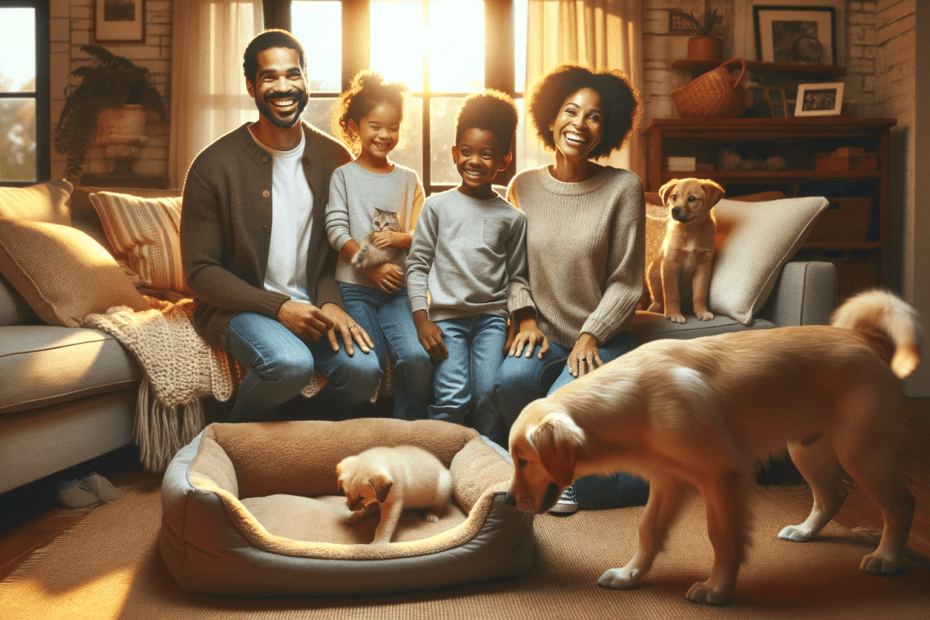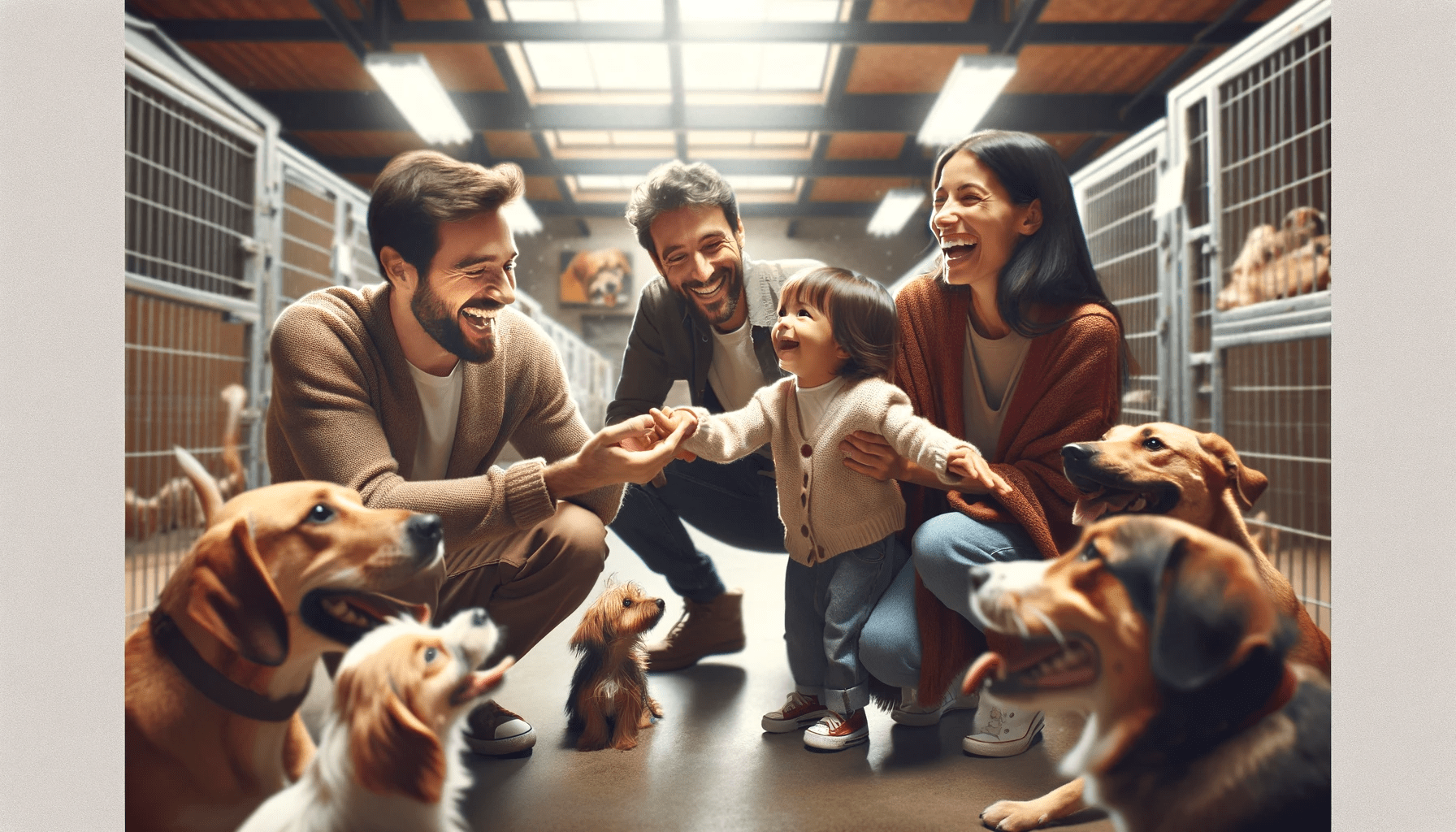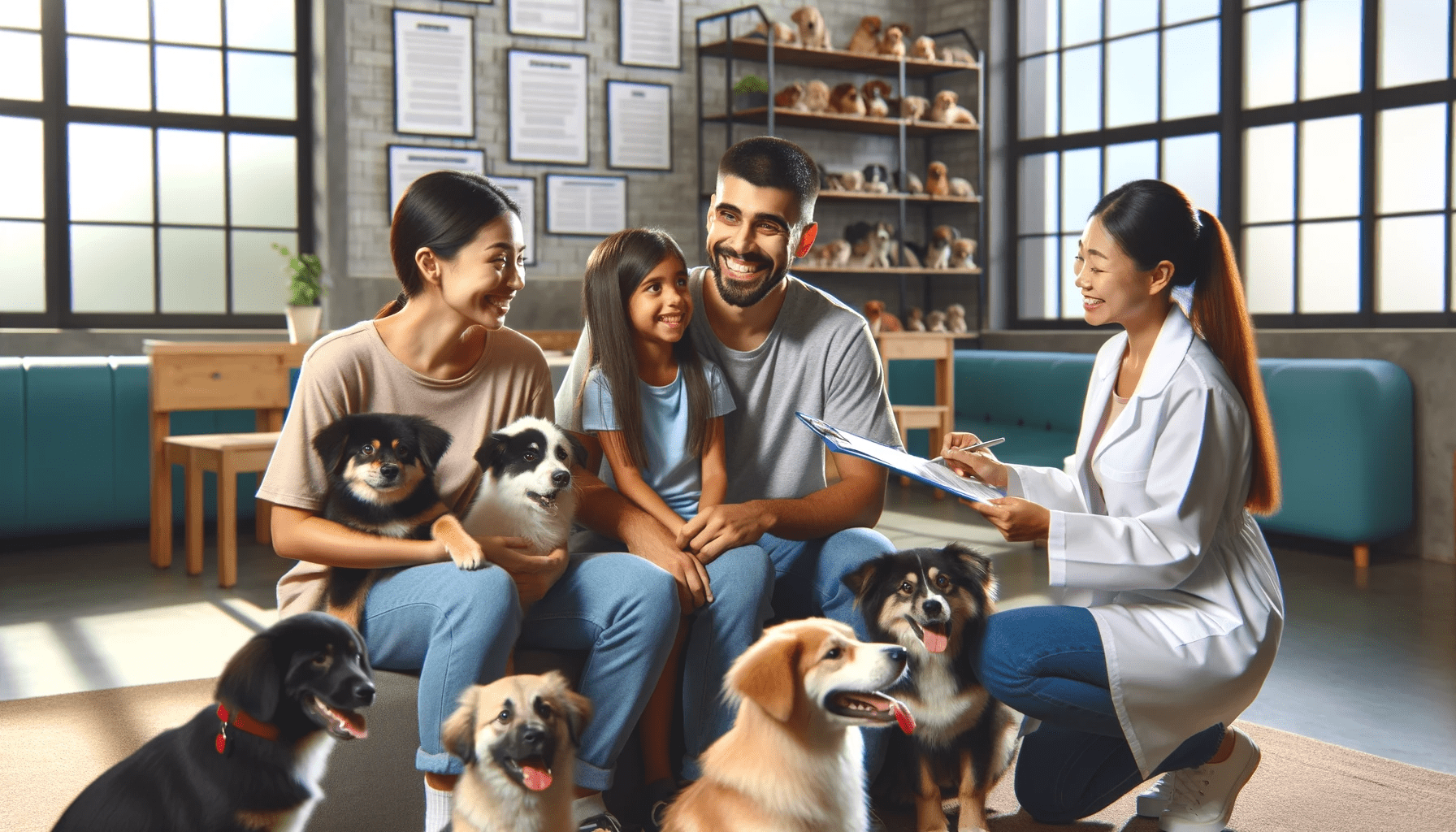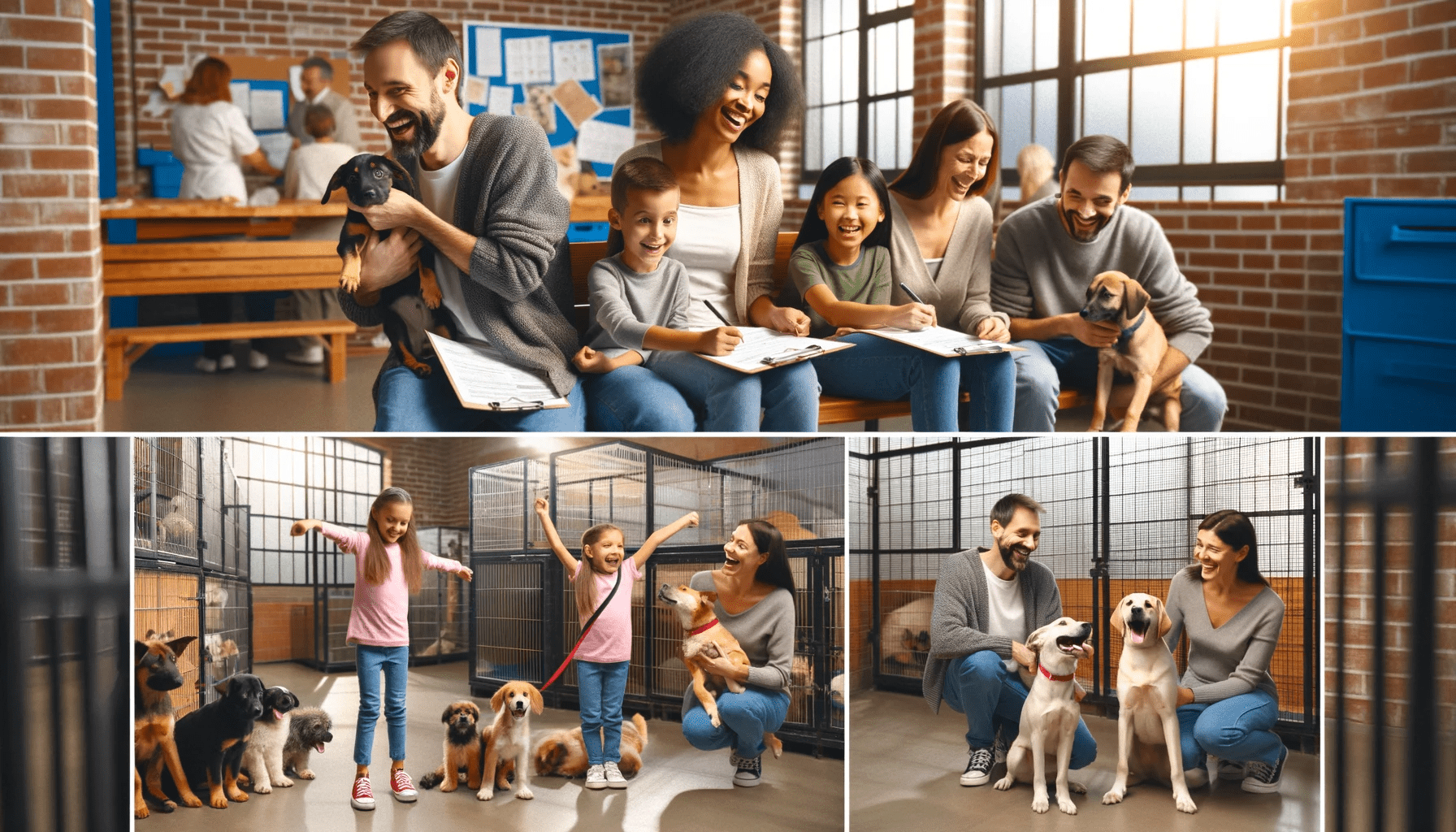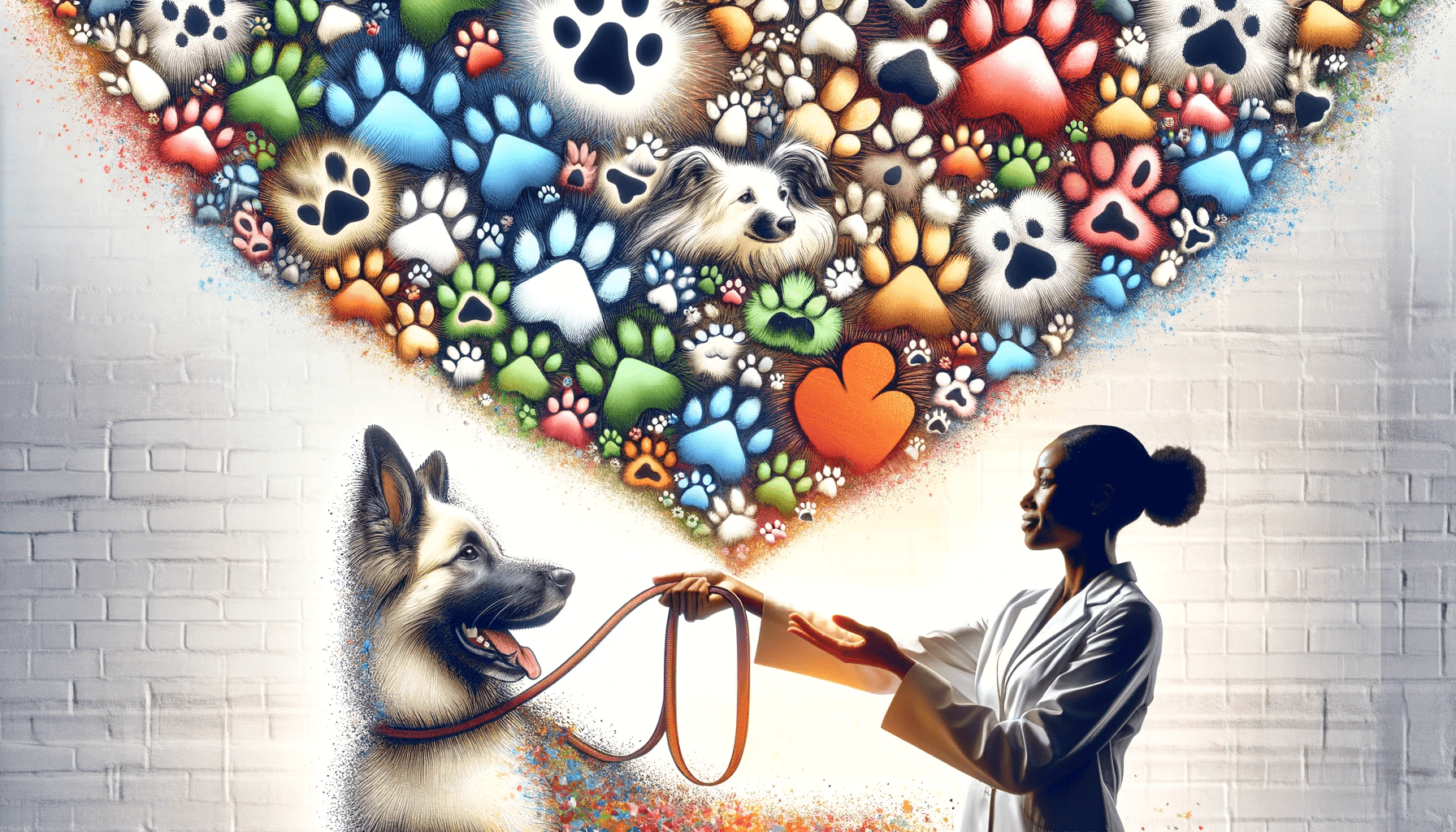Are you ready to welcome a new furry friend into your home?
Introducing a new adopted dog to your pets can be an exciting but challenging process. With the right approach, you can ensure a smooth transition for everyone involved.
From preparing your home to gradually introducing the new dog, this article will provide practical tips to help you create a harmonious environment for all your pets.
Get ready to embark on this rewarding journey of bringing a new dog into your family!
Key Takeaways
- Create a designated space for the new dog and establish a routine for feeding, walks, and playtime.
- Ensure the safety of all pets involved by taking the introduction process slow and gradual and providing safe spaces for each pet to retreat to.
- Slowly introduce the new dog by starting with separate spaces and using controlled introductions with leashes or gates.
- Supervise initial interactions closely, watching for signs of aggression or fear, and be prepared to separate pets if necessary.
Preparing Your Home for a New Dog
Before bringing a new dog into your home, it’s crucial to prepare your living space for their arrival. This pre-adoption preparation will help ensure a smooth transition for both you and your new furry friend. If you have children, it’s especially important to take certain steps to introduce your new dog to them in a safe and positive manner.
Firstly, it’s essential to create a designated space for your new dog. Set up a comfortable bed or crate where they can retreat to when they need some alone time. Make sure this area is quiet and away from any potential disturbances. Additionally, childproofing your home is vital. Store away any small toys or objects that could be hazardous to your new dog. Teach your children to be gentle and respectful towards the new dog, and supervise their interactions to prevent any mishaps.
Furthermore, it’s highly recommended to establish a routine for your new dog. Dogs thrive on structure and predictability, so having a consistent schedule for feeding, walks, and playtime will help them feel secure in their new environment. Involve your children in these activities, allowing them to participate in the care of the dog under your supervision.
Ensuring the Safety of All Pets Involved
To ensure the safety of all pets involved in the introduction process, it’s important to take it slow and gradually introduce the new dog to your existing pets. Keep a close eye on their initial interactions and be ready to intervene if necessary.
Additionally, establish a safe space for each pet where they can retreat to if they feel overwhelmed or need some alone time.
Slowly Introduce New Dog
When introducing a new adopted dog to your pets, consistently and gradually introduce the new dog to ensure the safety of all pets involved. This process requires patience and careful planning to build positive relationships between your pets.
Here are some steps to help you introduce your new dog slowly and safely:
- Separate spaces: Provide separate spaces for each pet initially, allowing them to become familiar with each other’s scent without direct contact.
- Controlled introductions: Start with short, supervised interactions between your pets, using leashes or gates to maintain control and prevent any potential conflicts.
- Positive reinforcement: Reward your pets with treats or praise when they display calm and friendly behavior towards each other.
- Gradual integration: Increase the duration and frequency of interactions gradually, always monitoring their behavior closely.
- Professional help: If you encounter difficulties or signs of aggression, seek guidance from a professional dog trainer or behaviorist.
Supervise Initial Interactions
During the initial interactions, make sure to closely supervise the new adopted dog and your existing pets to ensure the safety of all animals involved. This is an important step in introducing a new dog to your household. Supervising interactions allows you to intervene if any negative behaviors occur and prevents any potential harm.
Keep a close eye on their body language, especially signs of aggression or fear. It’s crucial to create a positive and calm environment during these initial interactions. Use positive reinforcement training to reward good behavior and discourage any unwanted behavior.
Give each pet their space and gradually increase their time spent together. Always be prepared to separate them if necessary. By closely supervising their interactions and using positive reinforcement training, you can help ensure a smooth and safe transition for all pets involved.
Establish Safe Space
Ensure the safety of all pets involved by creating a designated safe space. This will help establish boundaries and provide a sense of security for your current pets and the new dog. Here are some practical steps to follow:
- Create a separate area: Set up a room or a gated-off section where your new dog can have their own space. Make sure it’s comfortable and has all the necessary supplies like food, water, toys, and a bed.
- Introduce slowly: Start by allowing your current pets to sniff around the safe space while the new dog isn’t present. This will familiarize them with the scent before any direct interactions occur.
- Gradually integrate: Once your new dog has settled in, gradually introduce them to the rest of the house and the other pets. Start with short, supervised interactions and gradually increase the time as they become more comfortable with each other.
Gradually Introducing the New Dog to Existing Pets
Now that you have brought your new adopted dog home, it’s important to introduce them to your existing pets gradually. This process allows all animals involved to adjust and become familiar with each other’s scents and presence.
Slowly Integrating New Dog
Take the time to carefully introduce your new adopted dog to your existing pets, using a slow and gradual approach. This will help in integrating the dogs and building trust between them. Here are some practical tips to make the process smoother:
- Separate spaces: Give each pet their own space initially, like separate rooms or crates, to prevent any immediate conflict.
- Scent swapping: Exchange bedding or toys between the new dog and existing pets to help them become familiar with each other’s scent.
- Controlled introductions: Start with short and controlled interactions, such as on leash or through a baby gate, while closely monitoring their behavior.
- Positive reinforcement: Reward good behavior and provide treats or praise to both the new dog and existing pets when they interact calmly and positively.
- Gradual integration: Slowly increase the duration and proximity of their interactions over time, always prioritizing safety and comfort.
Managing Initial Pet Reactions
Introduce the new dog to your existing pets gradually to manage their initial reactions. This is an important step in ensuring a smooth and peaceful integration.
One way to do this is by introducing the pets through scent. Start by swapping bedding or toys between the new dog and your existing pets. This will help them become familiar with each other’s scent, reducing potential aggression.
Another method is to use a baby gate or a crate to create a physical barrier between the new dog and your other pets. This allows them to see and smell each other without direct contact.
As they become more comfortable, you can gradually increase their interaction time and monitor their behavior closely. Remember to reward positive behavior and provide a safe and calm environment for all your pets during this process.
Ensuring Harmonious Pet Dynamic
As you continue to manage the initial reactions of your pets, it’s important to gradually introduce the new dog to your existing pets to ensure a harmonious pet dynamic. This process should be approached with patience and caution to minimize stress and promote positive interactions. Here are some steps to follow:
- Establishing Boundaries:
- Create separate spaces for each pet initially, allowing them to become familiar with the new scent and presence without direct contact.
- Use baby gates or crates to create physical barriers, giving each pet a safe space to retreat to if needed.
- Positive Reinforcement Training:
- Use treats, praise, and rewards to encourage calm and friendly behavior from all pets during the introduction process.
- Gradually increase the duration and frequency of supervised interactions, rewarding good behavior and redirecting any signs of aggression or tension.
Monitoring and Managing Initial Interactions
Ensure that you closely observe and control the initial interactions between your new adopted dog and your existing pets. This is especially important when managing anxious pets or introducing the new dog to children. Monitoring these interactions will allow you to intervene if any signs of aggression or fear arise, ensuring a safe and harmonious transition.
When introducing your new dog to anxious pets, it’s crucial to create a calm and controlled environment. Begin by keeping the initial interactions short and supervised, gradually increasing the duration as your pets become more comfortable with each other. If any signs of anxiety or stress are observed, such as excessive panting, trembling, or hiding, separate the animals and try again later.
Introducing a new dog to children requires extra vigilance and supervision. Children may not understand how to approach or interact with the dog properly, which can lead to misunderstandings or accidents. Teach your children to approach the new dog calmly and gently, avoiding sudden movements or loud noises. It’s important to emphasize the importance of respecting the dog’s space and not overwhelming them, especially during the initial interactions.
Establishing a Routine and Structured Environment
To create a smooth transition for your new adopted dog, it’s important to establish a routine and structured environment for them to thrive in. By setting boundaries and providing consistent training, you can help your new furry friend feel secure and adjust to their new home.
Here are some practical tips to help you establish a routine and structured environment:
- Establishing Boundaries:
- Introduce your new dog to their designated spaces, such as their sleeping area, feeding spot, and potty area.
- Use baby gates or crates to create boundaries and limit access to certain areas of your home.
- Teach your dog basic commands like ‘sit,’ ‘stay,’ and ‘leave it’ to establish boundaries and reinforce good behavior.
- Consistent Training:
- Set a consistent daily schedule for feeding, exercise, and playtime. Dogs thrive on routine and knowing what to expect.
- Use positive reinforcement techniques, such as treats and praise, to reward desired behaviors.
- Be patient and consistent with training sessions, keeping them short and frequent to maintain your dog’s attention.
Addressing Any Behavioral Issues or Conflicts
Now that you have established a routine and structured environment for your new adopted dog, it’s time to address any behavioral issues or conflicts that may arise.
Managing aggression is one of the most common behavioral issues that pet owners may encounter. It’s important to understand that aggression can stem from various factors, such as fear, territoriality, or past experiences. To address this, it’s recommended to consult with a professional dog trainer or behaviorist who can assess the situation and provide guidance on how to manage and modify the aggressive behavior.
In addition to managing aggression, introducing your new dog to children requires careful consideration. Children and dogs should always be supervised when interacting to ensure the safety of both parties. Teach your children how to approach and interact with the dog calmly and gently, avoiding sudden movements or loud noises that may startle the dog. Encourage your children to respect the dog’s boundaries and not to disturb them while eating or sleeping. It’s also important to teach your dog basic obedience commands, such as ‘sit’ and ‘stay,’ which can help establish a positive and controlled interaction between the dog and children.
Seeking Professional Guidance if Necessary
If you encounter any difficulties or are unsure how to address behavioral issues or conflicts with your new adopted dog, it’s advisable to seek professional guidance. Professional training and advice can make a significant difference in helping you navigate any challenges that arise during the introduction process.
Here are some reasons why seeking professional guidance can be beneficial:
- Expertise: Professional trainers and behaviorists have the knowledge and experience to understand and address various behavioral issues. They can provide you with valuable insights and strategies tailored to your specific situation.
- Safety: If there are aggressive or fearful behaviors exhibited by your new dog, it’s crucial to prioritize safety for all pets involved. Seeking professional guidance ensures that you have the necessary tools and techniques to manage potentially risky situations.
- Peace of mind: Introducing a new dog to your existing pets can be a stressful experience. Professional trainers can offer guidance and support, alleviating your concerns and providing reassurance that you’re on the right track.
- Long-term success: By investing in professional advice, you’re setting a solid foundation for a harmonious relationship between your pets. The guidance you receive can help prevent future conflicts and promote a positive and balanced environment.
Frequently Asked Questions
How Long Does It Typically Take for a New Adopted Dog to Adjust to Their New Home and Feel Comfortable Around Existing Pets?
It typically takes a few weeks for a new adopted dog to adjust to their new home and feel comfortable around existing pets. Signs of successful integration include calm behavior and positive interactions. Here are some tips for creating a harmonious pet household.
What Are Some Signs That Indicate the New Dog Is Not Getting Along With the Existing Pets and May Need Professional Intervention?
If your new dog is showing signs of aggression, excessive fear, or anxiety towards your existing pets, it may be time to seek professional intervention. Factors like adjustment time, training techniques, age, breed, and health precautions can all impact the success of introductions.
Are There Any Specific Training Techniques or Exercises That Can Help Ease the Introduction Process Between the New Dog and Existing Pets?
To ease the introduction process between your new dog and existing pets, try using training techniques and bonding exercises. These can help them become familiar with each other and build a positive relationship.
Can the Age or Breed of the New Dog Affect How Smoothly the Introduction Process Goes With Existing Pets?
The age and breed of the new dog can impact how smoothly the introduction process goes with your existing pets. It may present potential challenges, but with proper training and patience, you can help them adjust and form positive relationships.
Are There Any Potential Health Concerns or Precautions That Should Be Taken When Introducing a New Adopted Dog to Existing Pets?
When introducing a new dog to your pets, it’s important to consider potential health concerns and take necessary precautions. This ensures the well-being of all animals involved and helps prevent any potential issues from arising.
Conclusion
In conclusion, introducing a new adopted dog to your pets requires careful preparation, monitoring, and patience.
By creating a safe and structured environment, gradually introducing the new dog to existing pets, and addressing any behavioral issues or conflicts that may arise, you can help ensure a smooth transition for everyone involved.
Remember to seek professional guidance if necessary to ensure the well-being and harmony of your furry family members.
